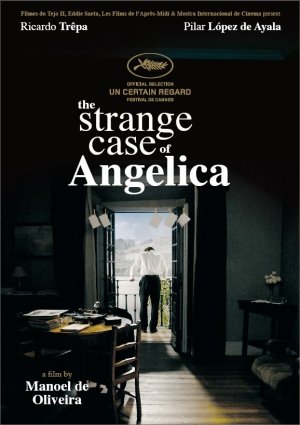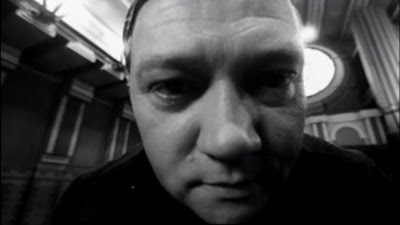Dir.: Reha Erdem
Turkey 2006
111mins
Part of the reason Turkish
cinema appeals to me – and this is very much an appeal to initiation, as Times and Winds is only the third
Turkish movie I’ve seen – is the familiarity of the landscape[1].
Having spent many summers rambling around Greek hillsides, somehow both arid
and green at the same time and fiercely hot, it’s interesting to see the kinds
of places I had so thoroughly associated with the rural practices of Greek
Orthodox Christianity just as deeply entrenched with the practices of Islam, with
a separation of perhaps only a few dozen miles. It is an almost uncanny experience,
if such a term can be applied to landscape. But of course it’s not just the
landscape – it’s its cultivation,
both in the agricultural sense and the more notional idea of how the character of
the land intertwines with the habits and practices of those who work it, who
live on it. In Greece one doesn’t need to walk past too many olive groves to
find a tiny white church, almost never visited but kept immaculately presented,
candles lit, or a cemetery with its ostentatious white marble and fading
adornments from the life of the deceased. On the northernmost cliff of the island of Skiathos
Quite why Ömer hates his father so much is never
properly explained. He is sullen and wilfully self-isolated – in one scene Ömer
silently refuses to budge closer to his father as the whole family of four
poses for a photograph – and so one gets the impression it’s simply teenage
disillusionment. (His father’s status as a religious community leader is also
refreshingly underplayed, and Ömer appears to suffer no more on this account
than if his father were a businessman or farmhand.) By contrast, his best friend
Yakup, with his noticeably unbroken voice, comes across as sweet and friendly;
he is also still something of a mummy’s boy and harbours a crush on their
schoolteacher that’s not nearly as secret as he might hope. The escapist
friendship between these two boys is the centre of the story, but it’s the peripheral
goings-on in the village that consolidate the film’s themes of fatherhood and
familial responsibility, while granting the viewer an insight into the reason
for the unexplainable feelings of discomfort the boys have in themselves, and
in the kind of grown men they may one day become.
Ömer’s secretive campaign to prolong his father’s
illness is initially the engine of the story. Straight away there is intrigue:
is the boy cruel, or will there be a revelation of abuse or maltreatment at
some point over the next two hours? For Erdem, this would be far too easy.
There is indeed an element of harsh patriarchy, but it comes from an unlikely
source. In one of the most revealing of the aforementioned peripheral ‘adult’
story threads – and indeed it’s crucial that much in the village is kept from
the children, reinforcing the generational divide and piling on further
alienation – Yakup’s father is shown to be something of a runt in his own
father’s litter. The old man has handed over his land to his two adult sons for
cultivation; both have disappointed him in their failure to work it and respect
their inheritance, but the efforts of Yakup’s father are particularly deficient.
The grandfather’s dialogue consists entirely of chiding, accusing, and shaming
his sons. He orders them to each build a stone wall around their halves of
land, with distinctly lopsided results. What could have remained a tragi-comic
moment later topples into full-blown inter-generational bitterness as the young
Yakup witnesses his grandfather disparagingly kicking down the inferior wall.
His father (the intermediary generation) looks on, downcast. At this moment
Yakup’s disillusionment intensifies – are we always to remain subservient to our
fathers, be they ogre-like or merely pathetic? What Yakup feels here is shame –
he is ashamed of his own father. Something clicks into place, narratively
speaking. Yakup and Ömer move closer together, become blood brothers before
that ritual boyhood act is itself shown onscreen.
At this point I must reassure readers that Times and Winds is not as masculine a
movie as I’m making out. In fact the film’s most beguiling presence is the girl
Yıldız, whose fascinatingly indistinct character made me suspect that one or
both of the boys might benefit somehow from spending more time with her, and
not in a kind of pubescent sexual way either. I wanted them to broach the
divide, instead of merely yelling distant threats to tell her parents on her
after the boys catch the girls out watching and giggling over copulating
ponies. When I say her character is indistinct, I don’t mean it’s inadequately
drawn – quite the opposite. Where the boys are brooding, inarticulate, confused
individuals (as boys their age tend to be), Yıldız is quiet but controlled,
purposeful, and caring. And perhaps it’s the thirteen-year-old boy in me that
wants Yakup and Ömer to force a revealing confrontation with her. I can
remember all too well how strange girls
seemed at that age. Strange but appealing. It is through Yıldız that the film’s
first truly shocking moment occurs, and the viewer cannot help but feel that
she simply doesn’t deserve it. I will spoil no further (but rest assured, it’s
nothing morally problematic or harrowing).
The mood conveyed by the film as a whole – the
editing, the pace of storytelling, and particularly the impact of the music –
is rather a complex presentation. I’m tempted to even call it a ‘proposition’,
because it its effect is so curious. While there are plenty of scenes of the
children escaping for each other’s company in the wilderness, away from the
village elders and the protocols of the schoolroom, the potential for
romanticism (in the proper Wordsworthian sense) is constantly checked by Arvo Pärt’s
grandiosely sad score. These children play, but they do so wistfully; there is
a pervading sense of melancholy. It loads the whole movie down with
portentousness, and not in a bad way. In a thinner or more simplistically
sketched movie, the use of a score like Pärt’s could flag itself up as
emotional shorthand. But again Erdem is too tasteful to allow this to happen;
he handles his content wisely, deliberately and with adherence to realism.
However, this realism is stretched, if not
entirely broken, by the film’s own signature stylistic move, one that fits the
elegiac tone of Pärt’s music perfectly. I am referring to the impressionistic,
non-diegetic bird’s-eye shots of the children lying down (asleep?), surrounded
and occasionally covered by what’s on the ground around them: Yıldız mostly
hidden by purple flowers; Ömer among dust and rubble. These are beautiful
shots, no doubt about that, but difficult to interpret. I personally came away
with the impression that these moments, placed at intervals throughout the
film, are simply more emphatic variations on Erdem’s style of drawing attention
to the gravity surrounding his characters. There are shots that point uphill,
framing figures against the sky but making sure they’re rooted firmly in the
earth. The aforementioned poetry recital scene on the cliff-edge seems to
suggest both the danger of the drop and, conversely, the children’s sense of comfort
and safety in the mountains they know so well. Several shots follow the
children as they navigate the village, tracing their way round in the service
of an errand or perhaps some troublemaking. Sometimes it appears that the
children themselves are the centres of gravity; the camera is tethered to them,
as they in turn remain earthed to the Eastern
Mediterranean hills. Erdem’s 2010 film Kosmos features a man with a literally gravity-defying ability to
climb: it’s a magic-realist element that allows the camera to dance around the
character, picking up all the angles it can in a kind of dynamic interplay with
his impossible clambering up trees and across walls. There is no magic-realism
in Times and Winds, and so these
shots are much calmer as a result, but the principle is evident. (This is another
success of Erdem’s work: the style never outraces the possibilities of the
story.)
The film unfolds patiently, its themes are
complexly handled and not what I’d call “universal” – many of its observations
are non-transferable to urban settings, for instance – but it’s these beguiling
and moody shots of the children, laden with sadness, innocence and guilt, mostly
closed-off to their families, that will keep viewers compelled. There have been
plenty of arthouse movies over the last ten or fifteen years in which the
minutiae of a childhood existence are studied with such a slight, hands-off
approach that one wonders if the director is somehow afraid of interfering with
the supposed ‘essence’ and authenticity of their own child actors; thankfully, Times and Winds is not one of them. It
doesn’t just ‘observe’ and expect some kind of ‘truth’ to make itself known –
it has a properly robust story behind it, a great script, and many fine
performances. It doesn’t mind being manipulative, via its score among other
things, because it has the courage of its own convictions. It knows the viewer
will feel, and that feeling will be
of substance. And so a confident, subtle and very modern piece of work then.
Rightly lauded. Times and Winds is a
keeper.
Incidentally, I don’t know why all that waffle
about the Greco-Turkish War was necessary at the beginning of this entry. I
suppose the movie has got me thinking rather nebulously, placing myself back on
Aegean hillsides and dangerous cobblestones. I don’t have much rurality in my
memory banks, so it’s nice when something appeals.
I have also (predictably) failed to update this
page in a very long time. I intend to rectify this, but of course not every
movie I see I am compelled to write something about. The Bourne Identity, for instance – I saw that for the first time
recently and it’s good fun, but it doesn’t make me want to dive in. Another one
was the 1968 rape-and-torture-fest WitchfinderGeneral: a classic piece of grim British censor-baiting fare that
nevertheless left me unable to find an angle. And I did want to write about that one. (Perhaps I’ll have better luck with Blood on Satan’s Claw.) Brighton ’s own Cinecity Film Festival is upon us at the
beginning of November, so I’ll hopefully be able to file some shorter pieces
about some of those screenings. (And without the ability to include
screenshots! But that’s the most funnest part! Sulk.)
Anyway, if you are still reading, thank you. Feel
free to argue and call me an idiot who can’t read a simple Turkish arthouse
drama. Times and Winds has so much
more to it than this entry attempts to deal with, but as always, I’m not
claiming to be exhaustive. And I’m trying to avoid spoilers too, because
Unsequence is a place to recommend.
Until next time, which won’t be too long, I promise…
[1] At least, in the country’s sunnier regions. Reha
Erdem’s 2010 film Kosmos is set in
the far grimmer climes of the snowy and troubled north-eastern border states



















































